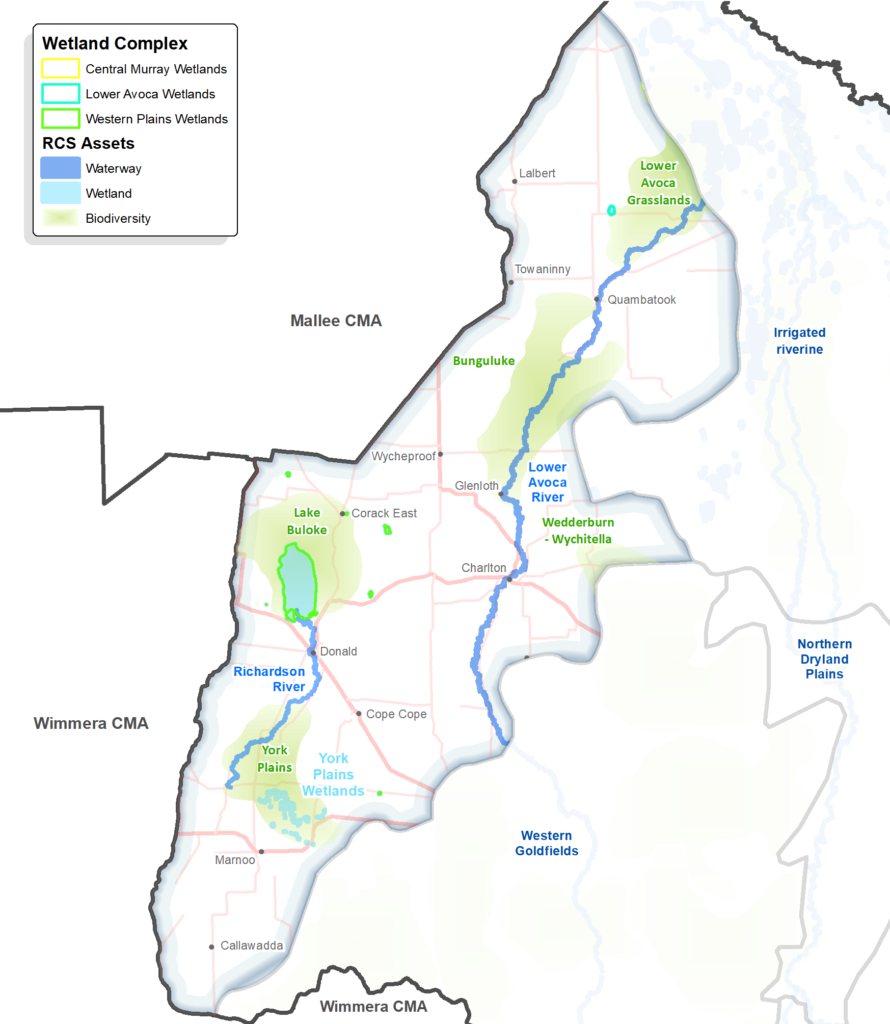Introduction
The Western Dryland Plains includes the traditional lands of clans represented by the Barengi Gadjin Land Council (west of Avon River), Dja Dja Wurrung (south-east of Lake Buloke and Avon River) and Barapa Barapa (north-east of Lake Buloke) peoples.
This is the westernmost part of the north central region, and the landscape is dominated by broadacre cereal cropping on large farms. Increased mechanisation of cropping enterprises, has led to fewer, larger farms and population decline in this area. A trend which has slowed, but is still ongoing.
Natural assets in this area include Lake Buloke, York Plains wetlands, the Bunguluke and Lower Avoca Grasslands. The Avon- Richardson Rivers and the lower Avoca River flow through this area.
There is a relatively low proportion of native vegetation in this landscape, and there are ongoing concerns regarding the illegal removal of native vegetation, particularly of threatened native grasslands.
This area has lower average rainfall compared with the south eastern parts of the region and waterways are vulnerable to the hotter, drier conditions predicted with climate change. The Wimmera Mallee Pipeline which replaced open channels, currently delivers environmental water to seven wetlands in this area, providing a much-needed refuge for wildlife. Waterways in this dry landscape are a precious resource, valued by community for: recreation, as green spaces which improve the livability of towns and for the environment. Through engagement for RCS renewal, we noted concerns regarding water quality in some areas, and some tensions between recreational and environmental uses.
In our changing climate, with reduced water availability overall, we anticipate sharing benefits will only become more challenging. It will be important to work together to raise awareness of water resource constraints and make the most of every drop. Integrated Water Management in urban areas will be important. Investigating opportunities to restore some natural flows to the Avon Plains wetlands and deliver environmental water to other wetlands have also been identified as priorities for this area.

A snapshot
| Aspect | Description |
| Key partners | Traditional Owners: Barengi Gadjin Land Council, Dja Dja Wurrung and Barapa Barapa. DELWP, Parks Victoria, Trust for Nature and Agriculture Victoria. Local Government: Gannawarra, Buloke, Northern Grampians shires. Landcare Networks: Murray Mallee, Buloke Northern Grampians Water Corporations: Grampians Wimmera Mallee Water (rural and urban). |
| Socio-economic | Relatively high socio-economic advantage. Ageing population. Farm amalgamations continue to contribute to population decline. |
| Bioregion | Wimmera |
| Native vegetation cover | Relatively low proportion of native vegetation. The Land Cover Time Series data for the period 2015-19 showed that native vegetation of some type covered just 14% of this area. |
| Rural residential or agricultural | Predominantly agricultural. Moderate percentage rural residential in areas west of St Arnaud and south of Swan Hill. |
| Agricultural land use | Predominantly dryland cereal cropping. The Land Cover Time Series data for the period 2015-19 showed that dryland cropping covered 83% of this area. |
| Soils and land use overview | Better known as Mallee country, these lands were formed during the retreat of the Murray Sea some two million years ago They comprise the remnants of coastal dunes and marine sands re-worked through wind action. With average annual rainfall less than 400 mm these are arid lands that are prone to wind erosion especially where the fine grained sediments including sands are exposed. Conservation cropping, cover-cropping and reduced traffic are all important approaches to managing these lands. |
Current and future challenges
The Western Dryland Plains continues to face many challenges including:
- Increasing mechanisation of cropping has reduced labour requirements and increased farm sizes (through aggregation) including corporate farms, driven by a history of continuing price pressures on producers.
- Farm aggregation leads to a declining population and volunteer base. Whilst the rate of decline has slowed and the largest towns of the area (Charlton and Donald) have stable populations, smaller towns are still experiencing population decline.
- Generally an ageing population, though farm aggregation and corporate farms generally attract younger farmers. Significant shifts in the farming demographic expected in the short-to medium term.
- Dry conditions exacerbate risk of wind erosion, maintaining groundcover important.
- The unregulated Avon Richardson and Avoca River systems and the Bunguluke priority biodiversity asset are vulnerable to drying under climate change, placing significant pressure on these ecosystems. Refer Bunguluke case study in the North Central Climate Change Adaptation and Mitigation Plan.
- Under climate change there are likely to be more floods, so community planning and preparation will be important.
- In this dry landscape, some tensions between uses of water are evident and under climate change sharing the benefits of this precious resource will be a challenge.
- There are ongoing concerns about illegal removal of native vegetation particularly threatened native grasslands.
Opportunities
Key opportunities for the Western Dryland Plains include:
- Participatory approaches where farmers work together on common challenges and solutions, including to better understand the future impacts of climate change, explore future scenarios and consider possible long term adaptation options.
- Improved engagement with corporate farms.
- Improved retention of native vegetation including threatened native grasslands.
- The Richardson River and Lake Buloke are priorities for the Barengi Gadjin Land Council.
- Solar farm developments in the north of this area, further supported by the proposed Kerang Link transmission upgrade, present an opportunity to work with developers to contribute to local biodiversity and other RCS outcomes.
Priority Directions and outcomes
The following priority directions are relevant to this Local Area only.
- Investigate environmental watering of other potential wetlands in the Wimmera Mallee pipeline area.
- Investigate opportunities to reconnect Avon Plains wetlands to increase natural flow conditions.
Other priority directions and outcomes of relevance for the Western Dryland Plains include:
Priority Directions:
- Deliver community-based participatory programs that build the capacity of land managers to improve land health.
- Work together to develop place-based climate change resources for landholders and managers, to inform adaptation.
- Build community awareness and capacity around the management of water resources and waterways, in the context of climate change.
- Improve the retention and restoration of native vegetation and habitat on private land through; community education and community-based programs that support stewardship and permanent protection, leveraging government and market-based incentives.
- Collaborate to increase awareness of legal requirements for the protection of native vegetation and habitat and improve compliance.
Outcomes (region-wide targets):
- Maintain an annual average percentage of no more than 20% exposed soils across the region, increasing area protected from wind and water erosion over the dry seasons, by 2027.
Priority directions relevant to the regional community generally, include:
- Build capacity, networks and leadership to enable community led climate solutions for land, water and biodiversity management.
- Support, improve and expand the environmental volunteering sector, including Landcare, to enable adaptation to demographic shifts, to continue their important role in NRM.
- Enable, improve and promote opportunities for people to connect with nature, in both urban and rural settings, for wellbeing, to build awareness and appreciation, and inspire action.
- Support schools and young people to participate in programs that increase their knowledge and awareness of natural resource management.
- Continue to support integrated citizen science programs that engage community and provide useful targeted data to inform water, land, climate and biodiversity programs.


